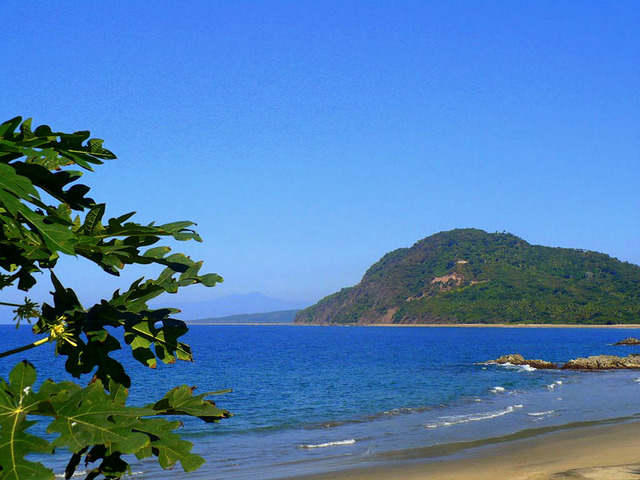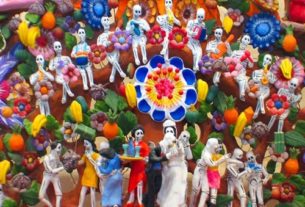Westwords
Artist James Vitale, owner and operator of El Encanto, a boutique eco-hotel or maybe a healing place or perhaps a vibrant retreat for creativity and education, came onto his verandah to say “Good morning, Mexico.”
Living in peace and tranquility in the pueblo of Santa Cruz de Miramar, between San Blas and Tepic in the state of Nayarit, Jim had come to expect the sunrise over his shoulder, frigate birds in the amapa tree, the surrounding cluster of beautiful plants and flowers and the silver shine on the passive Pacific ocean.

What he saw was a shocking encroachment. There was a bulldozer on the beach!
Vitale is really big on environmental integrity. He treats his seven acres and those around him with utmost respect. He cherishes the remnants of indigenous cultures. He strives for harmony with nature. There is no scrapheap at his house. Even lovely mango peelings go into the compost pile. Jim recycles wine bottles and broken tile into what may be modern art.
The bulldozer caught him off guard.
“What the hell is that doing here?”
The state government and maybe the feds were playing a game. The powers that be had decided to pour all the pesos from a civilization grant into a sewer-treatment plant. For that, they needed a sewer line. And for that, they needed the bulldozer.
Vitale was ticked. There had been no clue this was coming, not even a warning whisper. Focus groups? Are you kidding? Environmental impact study? What a joke!
Politicians and contractors got together and almost wore out the ink pad with stamps of approval.
For those who have missed this treat, El Encanto is a little slice of paradise, an old estate rescued from ruin and retooled into oceanfront rustic rooms. On the other side of a private road are jungle apartments in a hideout of palm trees. From the oceanfront row, you can see such delightful sights as fishermen far out in little boats and pelicans parked on leftover posts from an old pier. From the mirador, you can see forever.
On this fateful morning, all Vitale could see was that blasted bulldozer.
The artist became a researcher. He asked many questions. Maybe he raised his voice and waved his arms. He learned about a government development plan which talked of ecotourism but was actually based on money. Would any virgin beach survive or would Santa Cruz de Miramar become all jet skiis and water slides?
Like it or not, the government built that waste-treatment plant smack in El Encanto’s front yard. Hideous electric lines were stretched across El Encanto’s magnificent view.
“What they built was a non-functioning monstrosity,” said Vitale. “Four families hooked up to the sewer line. The machinery has never operated properly. Medium-sized waves lap over into the holding pool. There is the forever promise that the first big storm will contaminate the bay.”
Vitale, with eyes trained to see beauty and a nose for natural perfume, knows this ain’t it.
“Now and then we get a puff of raw sewage. There was one eruption at a main intersection in Santa Cruz.”
The government reacted in typical government fashion: “Live with it. This is progress.”
Vitale launched a counterattack. He set out banana trees to hide the unsightly concrete structure. He added fragrant flowers. He developed an organic garden to attract hummingbirds and produce food, herbs and medicinal plants. He became an even better good neighbor, raising funds for community projects and promoting a bilingual library. He found happiness all around.
El Encanto has roots. It was thought to be a pre-Columbian settlement. It became part of a hacienda built by Germans in the 1800s. They were going to process honey and produce coconut soap for export to Europe. The Germans moved on at the start of World War II. In 1951, the governor of Nayarit bought most of the tract as his very own playground. His family sold the remains in the 1970s.
Vitale found it in 1987 and started the transformation with his own hands and a rare Mexican loan. When he ran short of money, he went home to Seattle and painted.
“Houses,” said Vitale, “not pictures.”
Vitale really is an artist. He’s had one-man shows in Seattle and Puerto Vallarta. He’s won awards for creating art from recycled junk. Samples of artistic tinkering are all about El Encanto.
Jim thinks outside the proverbial box. He offers exotic workshops, including tile art, mask-making, costume design and “deeply soothing yoga from the rooftop terrace overlooking the ocean.”
He even encourages guests with artistic inclinations to work collectively on a mosaic garden sculpture. We skipped that part.
Vitale seems grateful for guests. He allows them to pay a few extra dollars in exchange for that warm, fuzzy feeling of fitting in, avoiding conflict with nature and resenting intrusive bulldozers.


